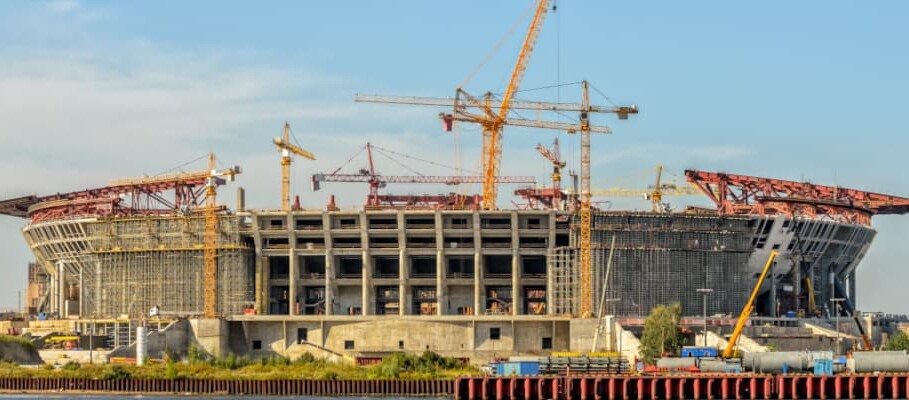The logistical marathon
A look behind the scenes of an international football tournament illustrates the complexity of logistics at major events. Starting with the production of balls in Asia and the manufacturing of jerseys in Europe, to the transport of stadium seating from North America – the supply chain in sports is a global network. Each step of this chain is associated with specific challenges: customs regulations, transport routes, storage and, finally, on-time delivery to the respective venues.
Customs regulations: a complex puzzle – using the example of the 2024 European Championship
Customs regulations pose a particularly significant challenge for international sporting events such as the 2024 European Championship. Take the import of fan merchandise, for example: jerseys, scarves and other merchandise are often produced in large quantities and must be transported to the host countries shortly before the tournament. A wide range of customs regulations, which differ from country to country, must be observed. The four most important aspects are as follows:
- Proof of origin: In order to benefit from favourable customs treatment, accurate proof of origin must be provided. This is especially important when products come from several countries and are finished in another country.
- Customs duties: The level of customs duties varies depending on the type of product and the country of origin. Different customs duties often apply to textiles and sporting goods.
- Security regulations: Many countries have strict security regulations that must be adhered to. For example, certain products such as fireworks or certain types of fan merchandise must be approved.
- Labelling requirements: Products often have to be labelled with certain markings to prove compliance with safety and quality standards.
For example, for Euro 2024, this meant that the organisers and the companies involved had to work with the customs authorities of the host countries well in advance of the tournament to ensure a smooth process. Not only the customs formalities for the import of goods, but also for the export of goods after the tournament must be observed.
Quality standard: the basis for successful sporting events
In addition to the logistical challenges and the sustainability aspect, quality standards also play a crucial role in major international sporting events. Both the sports equipment and the entire infrastructure must meet the highest requirements in order to ensure the safety of the athletes and to enable fair competition.
Compliance with international standards is essential. Organisations such as FIFA and the IOC set clear guidelines for the quality of sports equipment, playing fields and other equipment. These standards include, among other things:
- Materials: The materials used must meet certain quality requirements to ensure a long service life and optimal performance.
- Safety: Sports equipment must be designed in such a way that the risk of injury is minimised and athletes are not put at risk.
- Fairness: All sports equipment must meet the same requirements to ensure fair competition.
Maintaining these quality standards requires intensive quality control along the entire supply chain. From the production of the sports equipment to the final inspection on site, all processes must be carefully monitored.
Sustainability in sports: a must for the future
The sports industry is under increasing pressure to make its supply chains more sustainable. The transport of sports equipment and materials over long distances causes high CO2 emissions. In addition, questions about working conditions in the producing countries are in focus. To meet these challenges, many companies are focusing on sustainable materials, optimising transport routes and promoting fair working conditions. Taking the example of the FIFA World Cup 2022 in Qatar, 95% of the emissions were indirect emissions, mainly due to visitors' travel and transport of the required materials.
Concrete examples of the application of digital technologies for sustainability:
By using digital technologies, companies in the sports industry can not only make their supply chains more sustainable, but also more efficient and cost-effective. Digitalisation thus offers a great opportunity to make sports more sustainable and to make a positive contribution to environmental protection. These points can be optimised and implemented.
- Proof of recycled materials: Blockchain can be used to prove the origin of recycled materials and thus promote the circular economy.
- Optimisation of transport routes: With the help of IoT sensors and AI algorithms, transport routes can be planned to be as energy efficient as possible.
- Reducing waste: Digital platforms can help to reduce the amount of waste by making it easier to take back and recycle products.
Numerous opportunities for optimisation through digitalisation:
Companies are relying on innovative solutions to manage the complexity of global supply chains while increasing sustainability. These include the digitalisation of processes, the use of artificial intelligence to optimise transport routes and collaboration with sustainable suppliers. The following digitalisation trends can therefore make a significant contribution to future event planning.
- Blockchain technology: Blockchain can be used to make supply chains more transparent. Every step from raw material extraction to the end product can be tracked, enabling the traceability of materials and facilitating the verification of sustainability standards.
- Internet of Things (IoT): Sensors can be used in means of transport and warehouses to monitor transport in real time and optimise routes. This reduces empty runs and lowers CO2 emissions.
- Artificial intelligence: AI algorithms can analyse large amounts of data and thus help to optimise transport routes and predict demand. This enables better planning and reduces overproduction.
- Digital platforms: Digital platforms can facilitate collaboration between the various players in the supply chain and increase transparency.
Conclusion
Organising major sporting events is a logistical masterpiece that requires the coordination of global value chains. The challenge for the sports industry is to make these chains more efficient and sustainable. By managing customs regulations, reducing CO2 emissions and promoting fair working conditions, companies can make a positive contribution to the future of sport.

